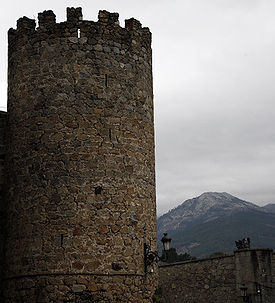
Arenas de San Pedro
Encyclopedia
Arenas de San Pedro is a municipality located in the province of Ávila
, Castile and León
, Spain
. According to the 2006 census
(INE
), the municipality has a population of 6,682 inhabitants. Its seal
depicts a large castle located in the town. The seal says "Siempre incendiada", meaning "always on fire" . This is because the town has been burned down and pillaged many times in its history.

Ávila (province)
Ávila is a province of central-western Spain, in the southern part of the autonomous community of Castile and León. It is bordered on the south by the provinces of Toledo and Cáceres, on the west by Salamanca, on the north by Valladolid, and on the east by Segovia and Madrid. Ávila has a...
, Castile and León
Castile and León
Castile and León is an autonomous community in north-western Spain. It was so constituted in 1983 and it comprises the historical regions of León and Old Castile...
, Spain
Spain
Spain , officially the Kingdom of Spain languages]] under the European Charter for Regional or Minority Languages. In each of these, Spain's official name is as follows:;;;;;;), is a country and member state of the European Union located in southwestern Europe on the Iberian Peninsula...
. According to the 2006 census
Census
A census is the procedure of systematically acquiring and recording information about the members of a given population. It is a regularly occurring and official count of a particular population. The term is used mostly in connection with national population and housing censuses; other common...
(INE
Instituto Nacional de Estadística (Spain)
The National Institute of Statistics is the official organisation in Spain that collects statistics about demography, economy, and Spanish society. Every 10 years, this organisation conducts a national census. The last census took place in 2001....
), the municipality has a population of 6,682 inhabitants. Its seal
Seal (device)
A seal can be a figure impressed in wax, clay, or some other medium, or embossed on paper, with the purpose of authenticating a document ; but the term can also mean the device for making such impressions, being essentially a mould with the mirror image of the design carved in sunken- relief or...
depicts a large castle located in the town. The seal says "Siempre incendiada", meaning "always on fire" . This is because the town has been burned down and pillaged many times in its history.


